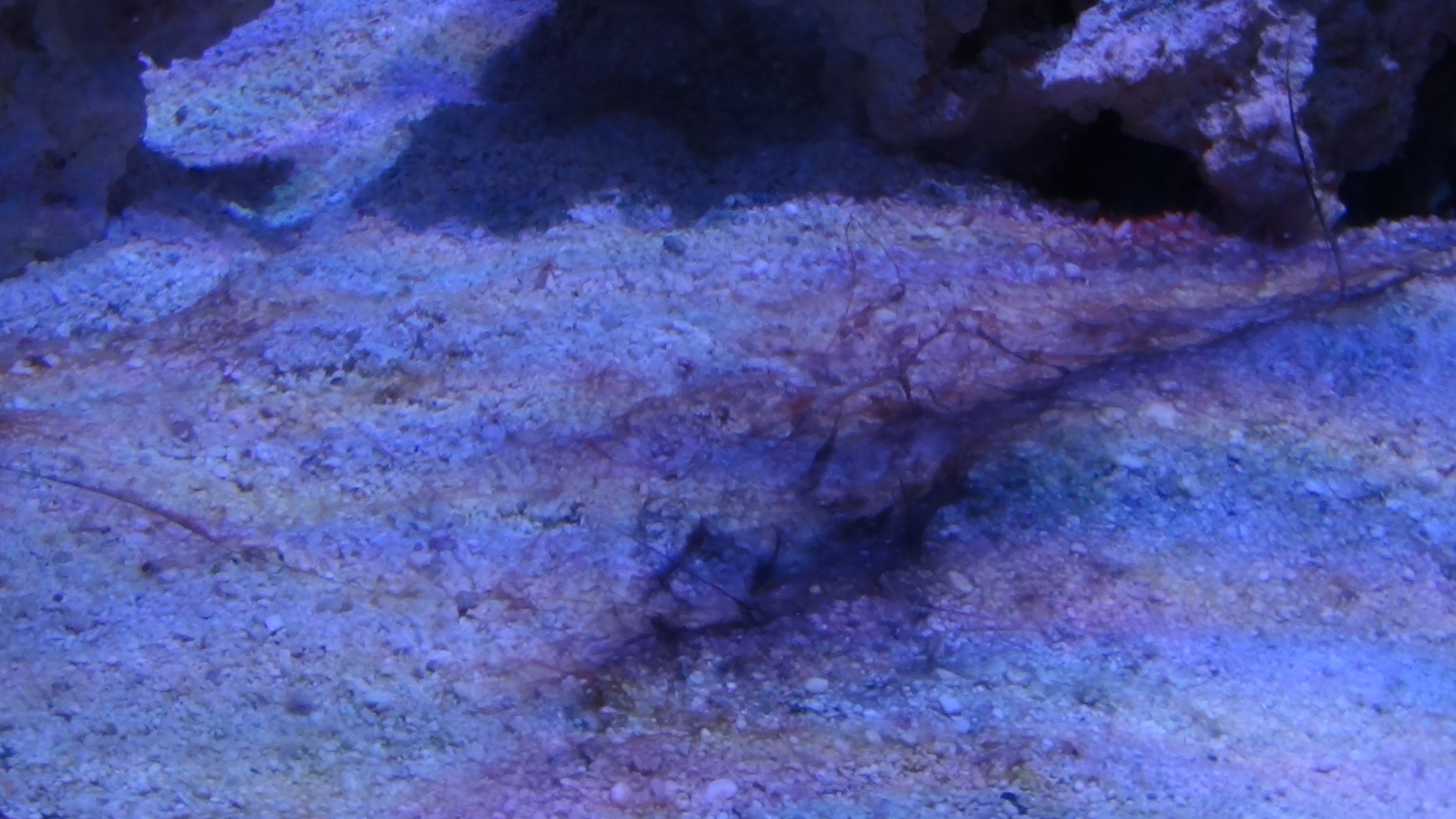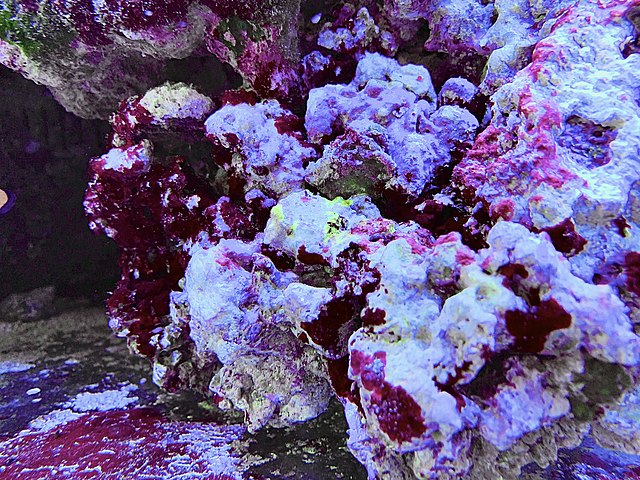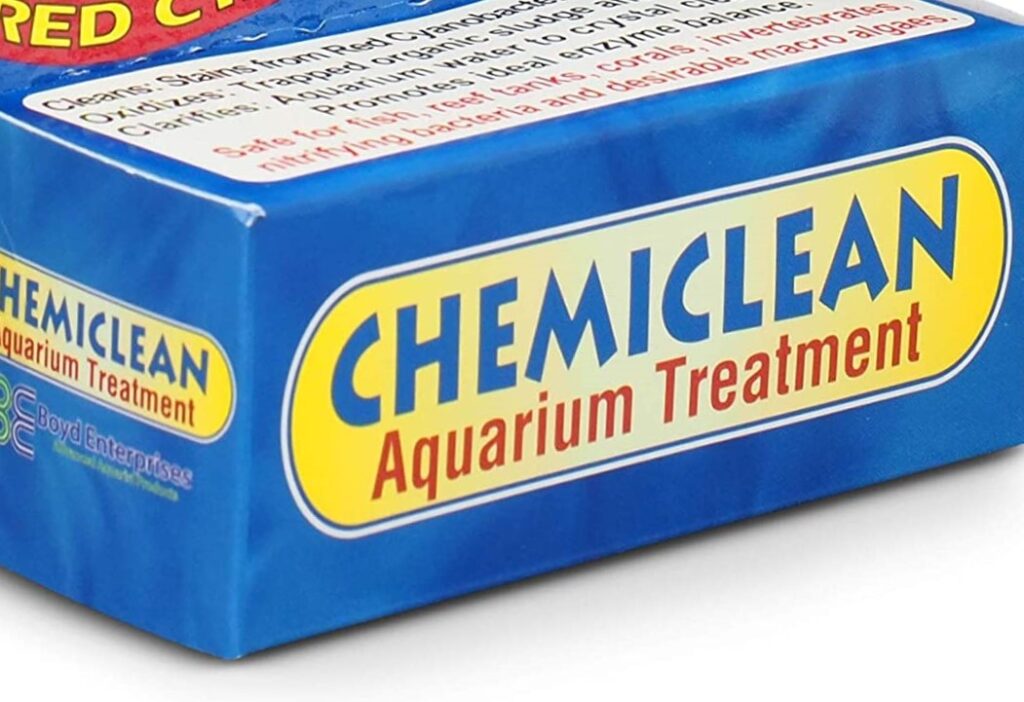
Red Slime algae can occur in any saltwater aquarium, but it is technically called cyanobacteria. This unsightly algae (bacteria) can be a nuisance for so many hobbyist who have saltwater aquariums or reef tanks. The red stuff can cover your sand bed, live rocks, and even your corals. It makes your aquarium look ugly, and it is important to remove cyano from your marine tank.
This problem can arise for beginners as well as experienced marine tank owners, so don’t feel like you messed up because you get this.
In addition to being unsightly, it can be harmful to your corals. It is important to understand what causes Cyanobacteria, how to prevent it, and how to get rid of it. Beginner and skilled aquarium owners can experience these outbreaks.
First it is important to understand what exactly is red slime algae (cyanobacteria)?
Table of Contents
What Is Cyanobacteria?

Cyanobacteria is photosynthetic bacteria that grows in water. It is thought to have been around for billions of years on Earth. This bacteria has been extremely important over time, and it emits oxygen. It can make its way into saltwater aquariums which is what we will look at in this article.
Cyanobacteria is also sometimes called blue-green algae, even though it is technically not an algae. There are multiple types of cyano which can make it difficult to diagnose if you are a new hobbyist to saltwater tanks.
What Does Red Slime Algae Look Like?
Cyanobacteria can be red, green, brown, or even black colored. It can also have different hues for each of those colors. It looks like algae that can cover your sand bed, your live rocks, frag plugs, and corals. Red Slime can be difficult to identify sometimes because it comes in several different colors, and it can present differently based on several different factors. One person’s aquarium with red slime can look different from another’s. It can even look like a purple colored mat.
This bacteria is slimy to the touch which is where it gets the name “red slime algae.”
Causes Of Red Slime Algae In Aquariums
The most common cause of a red slime algae outbreak in your saltwater tank is an imbalance of nutrients, most importantly, nitrates and phosphates. There is a lot of speculation in the reef community about what causes cyano including high nitrates, dirty water, high phosphates, not enough flow, incorrect lighting, and over feeding.
If you watch any YouTube video, or if you read any forum post, you are likely going to get a different answer on how cyano outbreaks occur. I have had an outbreak in a tank with a small amount of nitrate, so high levels of nitrates likely were not the cause of this specific outbreak of cyano. However, my TDS had risen in my RODI water, and my phosphates became high. For my saltwater tank, it seemed like ultra low nitrates with high levels of phosphates helped to create a cyano bloom in my tank. Is this exactly what caused it? I can’t be 100% positive, but it was the only thing out of whack.
There are several things to consider if you experience cyano in your tank.
Here are some reasons why your nutrients can get unbalanced which can lead to a red slime algae outbreak:
- High Nitrates: This is the primary cause of cyanobacteria. This can be from dirty filters socks, infrequent water changes, poor on no protein skimmer, etc.
- High Phosphates: This can be caused by poor water quality, not using RODI water, overfeeding, etc.
- Insufficient Filtration: You obviously need appropriate mechanical, chemical, and biological filtration to keep your nutrient and phosphate levels down.
- Inadequate Flow: A lot of people believe that certain areas of low flow can cause detritus to build up in stagnant areas.
- Insufficient Skimming: A properly sized Protein Skimmer is a must have to minimize the risk of red algae in your marine tank.
- Infrequent Water Changes: If you are not doing regular water changes, then your nutrient levels can become imbalanced.
- Not Testing Water Parameters: If you do not regularly test your nitrate and phosphate levels, then it will difficult to know if your levels are starting to get imbalanced, until it is too late.
- Not Using RODI Water: If you are not using RODI water, tap water can contain lots on unwanted things in it. While using a product like Prime will help, RODI is always the best choice for saltwater aquariums. Tap water contains silicates and other minerals that can promote the growth of unwanted algae and increased phosphates.
This is just a short list of factors that can contribute to an outbreak, but almost anything that invovles nutrient levels and phosphate levels can help to increase your risk for cyano.
How To Remove Red Slime Algae (Cyanobacteria)
There are several ways to get rid of red slime in your aquarium:
- Manual Removal
- Chemically
- Naturally
Manual Removal
One way to get rid of red slime algae is by manual removal. This is only going to be effective on surfaces that are easy to clean like glass and sand. It will be difficult to almost impossible to manually remove it from live rock by cleaning it off. You can use a new brush like a soft bristle tooth brush to clean your live rock, but this will depend on your tank size and how it is set up.
One of the best ways for manual removal is by using a siphon on your sand bed. This works great by cleaning the slime from the top part of your sand without getting too much sand in the siphon. A great way to do this is by pinching the hose during the siphon. This will cut off the flow and allow the heavier sand to fall back down.
You can also use different size tubing to siphon in areas around your rock and sand. You may not be able to get under the edge of your rock with a large siphon, but small airline tubing should be able to fit in tight spaces. Just use it like a siphon and pinch the hose when needed.
You can also use an aquarium fish net if you have heavy areas of cyano in isolated spots. Just scoop the top layer of sand with the red slime in it and dispose of it. If you get a thick coating on your sand bed, you can easily scoop up clumps of it. You can always add more sand back to your tank, although you should not have to remove much by skimming the top with a fish net.
Even if you want to use a treatment product, it is still recommended to remove as much cyanobacteria as possible before treatment.
Chemi-Clean

Chemi-Clean is a product that I have used in one of my aquariums before, and it worked great at removing cyano from my tank. Chemi-Clean is a great red slime remover. It oxides, cleans, and clarifies the water. It will help to oxidize trapped organic sludge, and it will help to remove red slime from your aquarium.
When I have used it, chemi-clean completely removed all cyanobacteria from my tank, and it did not harm anything. Actually, my zoa colonies looked much healthier after using it. This was a great treatment for my tank. You can read a full review of ChemiClean in my marine tank here.
Here is what makes ChemiClean so good:
- Safe for all fish, corals, inverts, macro algaes, and nitrifying bacteria
- Inexpensive
- Works on many stains of cyanobacteria
If you go the route of using this product, make sure you follow the directions closely. It is very important that you keep your tank aerated while using this product which is listed on the directions.
You can check out reviews and purchase this at Amazon.
Red Slime Stain Remover
Another chemical option is Ultralife Red Slime Stain Remover. I have never used this brand, but there are a lot of great reviews on its efficacy at removing red slime algae. It is a little less expensive than chemi-clean, but I have no results with it.
You can purchase this remover from Amazon here.
Red Slime Algae Eaters
If you want to add some inverts to your tank for natural removal, then there are a couple that may work. The problem with adding critters to consume algae is you will need enough, and it may take a while depending on how large your outbreak is.
Some hermit crabs are great at eating algae, including red slime. Dwarf Blue leg hermit crabs do a good job, and they may eat some cyano. Dwarf Red Tipped hermit crabs are probably better suited for red slime removal from the sand. These inverts do a great job of cleaning algae and red slime from the sand bed.
Electric Blue Hermit Crabs can also consume cyano from your aquarium.
Pencil Urchins will also remove red slime algae from almost any surface. These urchins are like garbage disposals in aquariums. If anything gets in their path, they will devour it. I had a large 3-4 inch diameter spot on my sand bed, and my pencil urchin parked right on top of it and completely removed it.
If you decide to add a pencil urchin for clean up, please keep in mind that these urchins are not reef safe, and they will eat almost anything in their path. Red slime algae eaters are a great way to keep small areas of cyano from popping up.
Again, it is important to consider what led to the overgrowth of red slime algae in your tank to begin with. Using inverts to clean it up is a great solution, but you will need to fix the problem or it will just keep coming back.
Do You Have To Remove Cyanobacteria From Your Tank?
You do not have to remove cyano from your tank. If you want to wait it out, you can certainly try this option. You do not need to remove it manually or put additives in your tank to get rid of it. However, if it is a severe outbreak, and it is affecting your corals, this is not the method that I would use.
The main reason to remove cyano from your tank (outside of harming corals) is the unsightly appearance it has. Most tank owners work hard to keep their tank looking pristine, and this will certainly keep your tank from looking nice. For people who work hard for pristine looking tanks at all times, letting it dissipate naturally over weeks may not be something that they are interested in.
It can also make your test kits inaccurate. Cyano may be consuming phosphates faster than you can measure. Your Phosphate levels may show normal, but in actuality, they are not.
If you work on your water parameters, reduce feeding, and carefully monitor your nitrates and phosphates, then the cyano should dissipate over time.
Prevention
- Maintain Phosphates <0.05 ppm
- Maintain Nitrates <10 ppm
- Stability
- Feed With Quality Foods
- Keep Healthy Biofilter
- Use Proper Protein Skimmer
- Routinely clean sump and skimmer
- Keep proper temperature (higher temps accelerates cyanobacteria)
- Keep proper flow throughout tank
Once you have cyano, you will want to make sure that you do not get it again. After clearing your tank of it, the next step is prevention. For this you will need to review what happened before you got the slime, and what possibly caused it. The best way to do this would be to understand your water parameters.
Hopefully, you have been regularly measuring your nitrates, phosphates, etc., and been consistent with water changes. It is also important to consider anything else that could have changed your tanks environment or chemistry. Some examples of this would be switching salt mixes, adding new lights, changing light schedules, etc. Are you measuring the TDS from your RODI water. If your filters are not working due to being old, then contaminants, phosphates, and silicates may be in your water. This will increase your risk for higher phosphates which can lead to an imbalance of nutrients. An imbalance can lead to a cyanobacteria outbreak.
You should definitely check your parameters before beginning any removal process. This allows you to have a better understanding of what could have potentially been the cause. If you do not have an understanding of what caused the problem, then it will be more difficult to prevent in the future.
Frequently Asked Questions
If your tank in new, cyanobacteria will go away on its own in 2-4 weeks. If you have an established tank, red slime may not go away on its own until the issue that is causing the problem is removed. This could be high nitrates or high phosphates.
Shrimp do not typically eat cyanobacteria.
